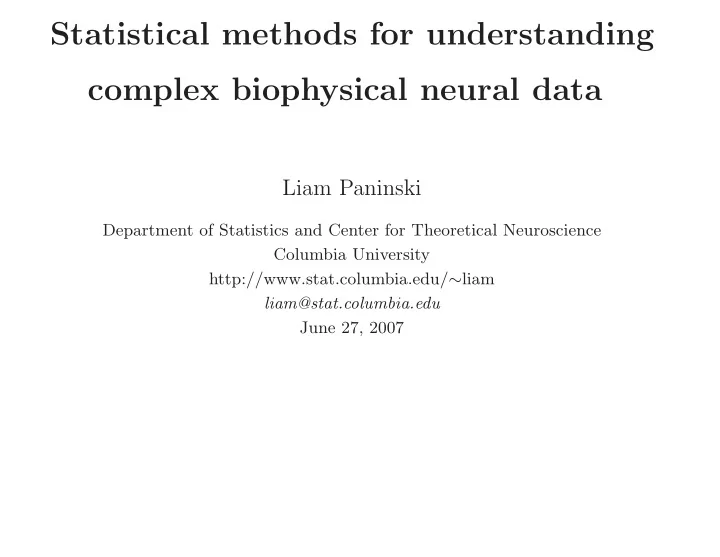

Statistical methods for understanding complex biophysical neural data Liam Paninski Department of Statistics and Center for Theoretical Neuroscience Columbia University http://www.stat.columbia.edu/ ∼ liam liam@stat.columbia.edu June 27, 2007
Back to detailed models Can we recover detailed biophysical properties? • Active: membrane channel densities • Passive: axial resistances, “leakiness” of membranes • Dynamic: spatiotemporal synaptic input
Spatiotemporal voltage recordings Djurisic et al, 2004
Conductance-based models Key point: if we observe full V i ( t ) + cell geometry, channel kinetics known + current noise is log-concave, then loglikelihood of unknown parameters is concave. Gaussian noise = ⇒ standard nonnegative regression (albeit high-d).
Estimating channel densities from V ( t ) (Huys et al., 2006)
Estimating channel densities from V ( t ) 0 −20 V −40 −60 50 summed currents dV/dt 0 −50 −100 20 40 60 80 100 Time [ms] conductance [mS/cm 2 ] 100 True Inferred 50 0 NaHH KHH Leak NaM KM NaS KAS
Measuring uncertainty in channel densities
Estimating non-homogeneous channel densities and axial resistances from spatiotemporal voltage recordings
A big cell
A big cell
Estimating synaptic inputs given V ( t )
Estimating synaptic inputs given V ( t ) B A without regularisation with regularisation [mS/cm 2 ] [mV] [mS/cm 2 ] Inh spikes | Voltage | Exc spikes 12 0 −47 −52 −57 23 0 0 0.05 0.1 0.15 0.2 0.25 0.3 0.35 0.4 0 0.05 0.1 0.15 0.2 0.25 0.3 0.35 0.4 Time [s] Time [s]
Estimating synaptic inputs given V ( t ) B A Synaptic conductances Channel conductances 120 True parameters max conductance [mS/cm 2 ] 1 (spikes and conductances) 100 Data (voltage trace) Inferred (MAP) spikes Inferred (ML) channel densities 80 Inh spikes | Voltage [mV] | Exc spikes 60 0 40 20 mV 20 −25 mV 0 HHNa HHK Leak MNa MK SNa SKA SKDR C 1 −70 mV 1 0 20 mV −25 mV −70 mV 1 0 0 1280 1300 1320 1340 1360 1380 1400 0 500 1000 1500 2000 Time [ms] Time [ms]
Estimating stimulus effects dV/dt = I channel + � k · � x ( t ) + σN t A 2 s 1 (t) 0 −2 B 20 0 −20 V −40 −60 C summed currents 150 100 dV/dt 50 0 −50 20 40 60 80 100 Time [ms] D E 120 4 True True 100 3.5 Inferred Inferred conductance 80 3 [mS/cm 2 ] filter 60 2.5 2 40 1.5 20 0 NaHH KHH Leak NaM KM NaS KAS 1 2 3 4 5 6 7 8 9 10
Dealing with incomplete observations: Kalman filter −59.5 V (mV) −60 −60.5 −59.6 E[V(t) | Y(0:t)] −59.8 V (mV) E[V(t) | Y(1:T)] −60 −60.2 −60.4 −60.6 est std (mV) 0.2 0.1 0 0 0.02 0.04 0.06 0.08 0.1 0.12 0.14 0.16 0.18 0.2 t (sec)
Spatiotemporal filtering compartment 5 10 15 compartment 5 10 15 compartment 5 10 15 0 0.01 0.02 0.03 0.04 0.05 0.06 0.07 0.08 0.09 0.1 t (sec)
Estimating parameters in the Kalman setting Simulated data: five-compartment model V ( t ), noisy observations 40 20 Voltage [mV] 0 −20 −40 0 1000 2000 Time [ms]
Estimating parameters in the Kalman setting intercompartmental conductance Leak 25 15 20 15 10 10 5 0 10 20 30 0 50 100 150 R Observation noise 2 50 40 1.5 30 20 1 10 0 10 20 30 0 10 20 30 EM iteration EM iteration
Smoothing given nonlinear dynamics — via particle filtering (Huys and Paninski, 2006)
Subsampling and noise
EM estimation via particle filter K Na 100 [mS/cm 2 ] 50 0 0 [mS/cm 2 ] Leak R Voltage [mV] [mS/cm 2 ] 4 2 20 40 60 EM iteration EM iteration
Particle filter to infer calcium from voltage observations
Inferring spike rates from calcium observations (play ohki movie here)
Collaborators Theory and numerical methods — J. Kulkarni, G. Szirtes, G. Fudenberg, K. Rahnama, Columbia — J. Pillow, E. Simoncelli, NYU — S. Shoham, Princeton — A. Haith, C. Williams, Edinburgh — M. Ahrens, Q. Huys, Gatsby — J. Lewi, R. Butera, Georgia Tech Motor cortex physiology — M. Fellows, J. Donoghue, Brown — N. Hatsopoulos, U. Chicago — B. Townsend, R. Lemon, U.C. London Retinal physiology — V. Uzzell, J. Shlens, E.J. Chichilnisky, UCSD Cortical in vitro physiology — B. Lau and A. Reyes, NYU
References Huys, Q., Ahrens, M., and Paninski, L. (2006). Efficient estimation of detailed single-neuron models. Journal of Neurophysiology , 96:872–890. Huys, Q. and Paninski, L. (2006). Model-based optimal interpolation and filtering for noisy, intermittent biophysical recordings. CNS*06 Meeting, Edinburgh .
Recommend
More recommend